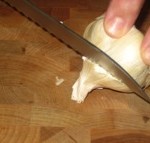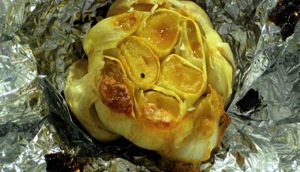We’re not supposed to assume anything, but in this day and age I assume that everyone likes garlic. I don’t limit its use or place in the meal when I cook for people. That goes for me too. With a head of garlic on hand, I feel as though I can conquer the world, or at least dinner.
Volumes have been written on garlic—it’s place in folklore, in civilizations and in the kitchen. But there seems to be one simple fact that gets glossed over in most cookbooks and that is garlic’s multiple personality disorder. I mean that in a good way. People who cook know this instinctively: Garlic cloves, like people, will behave differently according to the kind of treatment they are given. Raw garlic, in a salad dressing or in the French aioli or in marinades, has a sharp, biting quality, which I am not wild about. Here’s a better way to give a salad a very light garlicky touch, what the French call a chapon: Cut the end from a firm baguette and rub the cut side (lightly to heavily) with a peeled garlic clove. Toss the chapon along with the greens and the dressing then pull it out before you serve the salad.
Even light cooking, a flash in a hot pan, so to speak, tames garlic considerably. A good rule of thumb: work over moderate to low heat when cooking garlic in oil before adding the rest of the ingredients. Garlic tends to go from having no color at all to burning to a crisp in a matter of seconds, literally. A helpful hint to go with the rule of thumb- Let’s say you have sliced 4 or 5 cloves of garlic and have heated enough olive oil (over medium-low heat of course) in a pan to float the sliced garlic. Add the garlic and watch it carefully, shaking the pan from time to time. At first, it will bubble enthusiastically, then the bubbling will taper off and almost stop. Right after this, when most of the water has evaporated, is when the garlic starts to color. How much you let it color will determine the impact, for the most garlicky flavor, add the rest of the ingredients before it starts to color, for less, just as the slices start to turn tan around the edges. I wouldn’t go much past that, over-browned garlic is nasty. There is one salad I make that people love where I break this rule. Make sure the heat is low, and brown a ton of sliced garlic in a fair amount of oil, shaking the pan, until it is an even, nut brown. Be ready with a slotted spoon and a plate lined with paper towels. Turn off the heat, scoop out the garlic “chips” and drain them. Let the oil cool, add lemon juice, salt and pepper to it and toss this dressing with cooked string beans and halved cherry tomatoes. Just before serving it, scatter the garlic chips over the top. People think they are toasted sliced almonds every time. It is really good.
If garlic cooks for a long time in a braised dish or a stew it can lose too much of its personality. Add chopped raw or lightly sautéed garlic during the last 15 minutes of cooking to give it a boost. At any rate, this sliding scale of garlic flavor and intensity is exactly the nerdy kind of cooking thing that interests me.

Use a serrated knife to cut off the tip of the garlic bulb and remove the very tops of the cloves within
Lately, I have been getting it together enough to spend an hour in the kitchen on Sunday to make a bunch of staples that last through the week. Every other week or so, I will do a couple of heads of roasted garlic, which couldn’t be easier. Pick garlic for roasting like you would pick garlic for anything: big heads with a tight papery covering that feel compact and a little heavy for their size. (Good garlic is pretty easy to find, although it is better at some times of the year than it is at others. I recently ordered garlic from Purple Haze Garlic. I have heard it is wonderful and look forward to cooking with it.) Cut off the top ½ inch or so, a serrated knife is the only way to go here. Peel off most of the outer paper, but leave the heads intact. Take a sheet of aluminum foil and fold it in half. Center the head(s) of garlic over it and drizzle a tiny bit of olive oil over them. Make a neat little packet and put right on the shelf of a 400 F oven for 45 minutes. The cloves will be pretty soft at that point. Undo the packet a little and keep roasting until the tops of the cloves are browned, another 10 minutes or so. Roasted garlic is sweet and nutty, like Drew Barrymore. It can season anything from soups, tomato sauce and baked potatoes to cream cheese and hummus. Tonight, with all this garlicky talk, I plan to do a version of the old Italian standby, spaghetti with garlic and oil, using both lightly browned sliced garlic cloves and roasted garlic.
Someday I will attend the Gilroy Garlic Festival, but until then, I will hold my own festival weekly in my tiny apartment kitchen.




